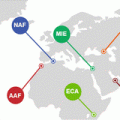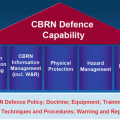© Springer Science+Business Media Dordrecht 2015
Samuel Apikyan and David Diamond (eds.)Nuclear Threats and Security ChallengesNATO Science for Peace and Security Series B: Physics and Biophysics10.1007/978-94-017-9894-5_33. To Pursue an Independent Nuclear Deterrent or Not? Japan’s and South Korea’s Nuclear Decision Making Models
(1)
Latin American Public Opinion Project, Vanderbilt University, Alamos, New Mexico, USA
(2)
National Security Office, Los Alamos National Laboratory, Alamos, New Mexico, USA
Abstract
Concerns regarding potential nuclear proliferation activities of South Korea and Japan have increased following recent nuclear tests conducted by North Korea and following regional hegemonic actions by China. Both of these countries have bilateral security agreements with the United States, and are covered under the so-called “nuclear umbrella.” This paper poses the question: If these countries enjoy these security guarantees, what factors could contribute to their decision to pursue proliferation activities? This paper reviews some of the relevant literature on nuclear-decision making before proposing that perhaps these models are complementary rather than competing. For the purposes of South Korea and Japan, this paper asserts that there are two contributing factors that could cause either country to engage in proliferation activities: loss of confidence in the U.S. commitment to its extended deterrence obligations and regional security threats. Using case studies, this paper reviews the past proliferation activities by these two countries, and examines the mitigating factors that led to past decisions, and how such similar factors could impact future decisions. This paper uses historical analysis and investigation of contemporary security issues to examine the roles that extended deterrence and regional security have played and may play in the future, in each country’s interests in engaging in increased nuclear proliferation-sensitive activities.
3.1 Introduction
There have been many theories as to why countries pursue nuclear weapons programs. Scholars have speculated that states seek nuclear weapons for a variety of reasons ranging from domestic politics to international security. These models seek to explain the phenomena of why some states develop nuclear weapons and why others abstain. This paper examines these models before turning to case studies. Based on this analysis, this paper proposes an additional way to think about a country’s nuclear decision-making.
There are over 30 states currently covered by the United States’ extended nuclear deterrent. The crux of this concept is that countries covered by this so-called “nuclear umbrella” need not develop independent nuclear programs because the United States will provide security guarantees in the event of a crisis. Since the formation of the North Atlantic Treaty Organization (NATO), it can be argued that the extended deterrent has been a powerful nonproliferation tool, discouraging a nuclear cascade in several regions. This paper concludes that the perceived “strength” of the U.S. nuclear deterrent plays a role in a given country’s nuclear decision-making. Strength here is defined as both numbers and types of nuclear weapons, rhetorical commitments, and military deployments. This definition will be further expanded upon throughout the paper. The two case studies used here are Japan and South Korea. This paper examines what role the strength of the U.S. nuclear deterrent played/plays in the nuclear decision-making of Japan and South Korea.
3.1.1 Existing Framework
In his article, “Why do States Build Nuclear Weapons? Three Models in Search of the Bomb,” Scott Sagan challenges the notion that states will proliferate if, and only if, they face an extreme security threat from another international actor. Sagan notes that such a focus fails to accept that “nuclear weapons programs also serve other, more parochial and less obvious objectives.”1 Models of decision-making have been put forth ranging from security to domestic to psychological. This introduction briefly explores some of these models before examining Japan and South Korea as case studies to propose another model, a confidence model. This paper concludes that confidence in the U.S.-provided nuclear umbrella matters, and should be taken into account when looking at a states nuclear decision-making. It should be noted that decision-making criteria do not exist in a vacuum. The model put forth in this paper is meant to supplement existing models: in no case has just one factor led to a state’s decision to pursue a nuclear weapons program. Often there are a variety of variables, although in some cases one variable may dominate over others—nevertheless, these models must be married to fully explain nuclear decision-making.
The security model is heavily influenced by realist international relations theory. Originally developed by Kenneth Waltz, the theory claims that international actors survive in an anarchic system, and as such they are solely responsible for their safety and security.2 Sagan sums up the security model with regard to this theory claiming, “because of the enormous destructive power of nuclear weapons, any state that seeks to maintain its national security must balance against any rival state that develops nuclear weapons by gaining access to a nuclear deterrent itself.”3 This is a relatively intuitive notion: if a state feels threatened by a neighboring state’s nuclear arsenal, it may be inclined to develop its own, independent deterrent. While intuitive, this model fails to identify the complexity involved in developing a nuclear arsenal, including budgetary, technological, and international constraints.
Etel Solingen moves beyond the security model to explore what domestic factors could play a role in nuclear decision-making. Solingen argues, “Different models of domestic political survival—how leaders seek to gain and maintain power—provide important information regarding nuclear decisions.”4 Solingen concludes that domestic issues are not the only variable, but are largely left out of the security model. She claims that without “taking into account political survival models, one may not properly understand nuclear behavior or estimate the actual effects of the balance of power, international norms and institutions, or democracy.”5 Similarly, this paper concludes that confidence in the U.S. extended nuclear deterrent is but one piece of the puzzle.
Solingen marries international factors with domestic factors. She claims that regional issues matter, explaining the “extent to which regions share congruent orientations toward internationalization (either positive or negative) modifies domestic preferences on nuclear issues.”6 Domestic politics do not exist in a vacuum. Leaders are aware of their place in the international system. With regard to East Asia, Solingen claims the “collective evolution of East Asia toward internationalization reinforced individual incentives of leaders to avoid nuclearization to preserve regional stability, foreign investment, and domestic growth.”7 As can be seen today, leaders who chose a path of proliferation are often deemed pariahs, sanctioned economically, and sometimes fought militarily. When a state is outwardly facing, trying to establish a place in the international community, they are less likely to pursue nuclear weapons programs, according to the domestic model. This model is compelling in that it does not claim to be the deciding factor of nuclear decision-making rather it claims that domestic issues must be taken into account in order to create a comprehensive understanding of such decisions.
3.1.2 Coupling Models: Regional Security and Confidence
In 1968 many of the world’s nations signed a document that would change the face of nuclear proliferation forever. The preamble of the Nuclear Nonproliferation Treaty (NPT) begins,
The States concluding this Treaty, hereinafter referred to as the Parties to the Treaty,
Considering the devastation that would be visited upon all mankind by a nuclear war and the consequent need to make every effort to avert the danger of such a war and to take measures to safeguard the security of peoples,
Believing that the proliferation of nuclear weapons would seriously enhance the danger of nuclear war,
In conformity with resolutions of the United Nations General Assembly calling for the conclusion of an agreement on the prevention of wider dissemination of nuclear weapons…8
The treaty continues to lay out 11 articles that are designed to stem the tide of nuclear proliferation. Forty-one years later, President Obama made another plea to the international community to achieve a world free of nuclear weapons.9 While this was an impassioned speech on a radical idea, President Obama made sure to assure the United States’ allies and assuage the United States’ adversaries. He explained, “Make no mistake: As long as these weapons exist, the United States will maintain a safe, secure, and effective arsenal to deter any adversary and guarantee defense to you allies.”10
The question is how does the United States balance both a reduction in the role and numbers of nuclear weapons in their national defense posture, while still extending the so-called “nuclear umbrella” to more than 30 friends and allies? Japan and South Korea are both allies of the United States and both enjoy bilateral defense agreements with the United States, are there circumstances under which either country may pursue nuclear proliferation related activities?
Two circumstances that could potentially push both Japan and South Korea into considering proliferation related activities are; regional security threats and the loss of confidence in the extended nuclear deterrent provided by the United States. This paper will examine these two issues and determine what, if any, relationship they have with the proliferation related activities of Japan and South Korea. In these cases, the security model is coupled with other variables, one of them being confidence in the U.S. provided extended deterrent.
3.2 South Korea
The United States and South Korea have a longstanding relationship. Ever since the North-South Armistice provided a tentative end to the Korean War, the United States has maintained troops on the ground in South Korea. The two countries have coupled this physical presence of both personnel and weapons systems with numerous statements regarding both a general and nuclear security guarantee from the United States.
It is important to understand the initial security relationship between these two states, as well as the historical roots of South Korea’s nuclear program.
Signed in 1953 the Mutual Defense Treaty between South Korea and the United States begins,
Each party recognizes that an armed attack in the Pacific area on either of the Parties in territories now under their respective administrative control, or hereafter recognized by one of the Parties as lawfully brought under the administrative control of the other, would be dangerous to its own peace and safety and declares that it would act to meet the common danger in accordance with its constitutional processes.11
This treaty was the first step in formal assurances to the South Korean people that the United States would clearly come to their aid in the event of an act of aggression by another state. It is important to note that there is no explicit language ruling the use of nuclear weapons on behalf of each other in or out.
As with any international treaty, the Mutual Defense Treaty existed in a specific historical moment. As Kang Cho and Joon-Sung Park explain, the treaty “was a joint product of South Korea’s desperate effort to keep U.S. forces committed to its defense and the U.S. recognition of Korea’s strategic value in fighting the spread of communism in Northeast Asia.”12
Just three years after signing the Mutual Defense Treaty, the United States reportedly introduced nuclear weapons on the Korean Peninsula, purportedly to maintain a credible security presence, despite a troop drawdown.13
3.2.1 The South Korean Nuclear Option
After the initial security guarantees of the 1950s, the South Korean-United States relationship was tested when South Korea explored its own nuclear option. It is useful to explore what the determinants were in South Korea’s nuclear decision-making and what the response of the United States was with regard to discouraging the nuclear option. Could the United States use this history as a template of how to curb any future South Korean proliferation activities?
In the early 1970s South Korea is believed to have pursued a nuclear weapon option. In 1970, “President Park established the Agency for Defense Development and the Weapons Exploitation Committee to produce or acquire weapons systems and military supplies.”14 Three years later, President Park’s “nuclear weapon program began to take concrete form, with reinforcement of nuclear research teams and the effort to acquire nuclear reprocessing plants as well as associated core designs and technologies from France.”15
With a security guarantee signed 20 years earlier, the proliferation activities of the 1970s beg the question: what were the circumstances in which South Korea felt it needed to attempt to pursue fuel cycle capabilities?
Christopher Hughes from the University of Warwick suggests, “South Korea’s perception of declining U.S. implacability in the face of North Korea provocations in the late 1960s, U.S. rapprochement with China in the early 1970s, and U.S. plans to scale back its troop deployments all galvanized President Park to seek nuclear weapons.”16 Richard Bush of the Brookings Institute echoes this sentiment in explaining that the nuclear initiatives “had two drivers: Seoul’s increasingly dire threat perception concerning North Korea and an apparent weakening of the U.S. security commitment.”17 Troop deployments are one tangible mechanism in which South Korea has measured the level of commitment from the United States.
3.2.2 Regional Security Issues Facing South Korea
What was happening in northeast Asia at the time of these nuclear activities? Could the security model be useful in explaining such activity? The armistice with the North has never been truly stable, and the 1960s and early 1970s were no exception. North Korea attempted to assassinate President Park Chung Hee, and committed several other acts of aggression such as “capturing [the] USS Pueblo, armed guerilla infiltrations, and shooting down the US EC-121 reconnaissance plane.”18 These acts are quite similar to what the international community is seeing today with the most recent provocations from North Korea.
South Korean scholar Seok-soo Lee explains how North Korea’s “provocative behavior culminated in an abortive guerrilla attack on the Blue House of presidential residence and infiltration of 120 North Korean special operations forces in 1968. In 1976, [an] ax accident occurred in the Joint Security Area with two casualties of American soldiers.”19 The Blue House raid was an attempt to essentially take over the country, theoretically after the attack, communist agents within South Korea would then mobilize to incite guerilla warfare.
These acts of aggression posed a great threat to South Korea. As a result, South Korea felt insecure and began to explore developing an independent deterrent. The time of these acts of aggression line up with South Koreas nuclear program. However, acts of aggression were not the only thing pushing South Korea to explore the nuclear option; South Korea was beginning to perceive the United States as wavering in their security commitments.
3.2.3 Loss of Confidence
Bush explains that prior to the late 1960s and early 1970s “South Korea was reassured by the mutual defense treaty and the deployment of, first, U.S. troops and then tactical nuclear weapons on the peninsula.”20 It was only when Washington was behaving in a manner that was disconcerting to Seoul, coupled with the security threats from North Korea that South Korea explored the nuclear option.
The aforementioned regional security issues were further exacerbated by the fact that South Korea was quickly losing faith in the United States’ capability to protect it. Washington was unable to come to the aid of Seoul during these provocations because it was preoccupied with the war in Vietnam. It is important to note, that the security guarantees are mutual, South Korea assisted the United States with Vietnam. Choi and Park note that South Korea sent “320,000 soldiers to Vietnam over an 8-year period and suffered more than 16,000 casualties including 5,000 killed in action.”21
Hughes suggests that the “possibility of the alliance dilemma of U.S. abandonment was what formed the prime driver for South Korea’s attempt at acquiring nuclear weapons.”22 How does the United States today keep the “alliance dilemma” under control? Would another large conflict that caused the United States to draw down its troop presence cause northeast Asian countries to begin weapons exploration? More importantly, to use the extended nuclear deterrent as a tool to keep potential proliferants from doing so, how can the United States identify and assuage specific fears of abandonment?
After pulling out of the war in Vietnam, President Nixon created a doctrine in which he called for more independence of Asian countries. In 1970, the United States created a plan to withdraw 20,000 troops from South Korea. This was coupled with a long-term plan to completely withdraw by 1975.23 Troop withdrawal was a real manifestation of the abandonment fears that South Korea felt. To make such a drastic draw down certainly triggered at the very least looking into a South Korean independent nuclear deterrent. Kurt Guthe and Tom Scheber of the National Institute of Public Policy argue, “When doubts about that commitment led South Korea to start a clandestine nuclear weapons program, U.S. assurances, along with other measures, caused Seoul to halt the effort and ratify the NPT.”24
Lee echoes this sentiment in stating that the South Korean regime under President Park was unconvinced that the extended conventional deterrent provided by the United States was enough. As a result of this, President Park, as mentioned earlier, began to explore nuclear weapons development. The United States applied great pressure to curb this behavior, and once they were successful, the United States “promised to provide the nuclear umbrella to South Korea.”25 This may have created a dangerous precedent as President Park was essentially rewarded for proliferation behaviors. It is important that the United States be cautious and ensures that proliferation activities by South Korea are not rewarded. The United States must be able to anticipate fear of abandonment and understand security threats, before these two variables lead to an increase in proliferation activity.
3.2.4 Contemporary Issues
There is little doubt that the acts of aggression from North Korea to South Korea have been egregious over the past decades. The Korean peninsula rests on a perpetual verge of conflict, with anywhere from 25 to 30,000 troops from the United States standing in the middle. South Korea has previously begun the early steps necessary for a nuclear weapons program at least once in the relatively short history since the armistice.26 This effort came at a time when South Korea was facing major security infractions from the north, and had lost confidence in the United States’ promises to protect.
What are the regional/confidence issues that face South Korea today? Are these extreme enough for South Korea to begin a nuclear weapons program? How can the United States assuage the fear of abandonment and manage the security environment?
On October 9, 2006, North Korea conducted an underground nuclear test. This came years after the 1994 nuclear crisis when North Korea threatened to leave the NPT, giving its compulsory 90 days and reneging on day 89, thus opening the door to pull out with one days’ notice, which they did in 2003. The test, while egregious, was not so surprising to many in the international community, as North Korea was moving in the direction of nuclear weapons for some time. The United Nations Security Council (UNSC) was quick to act in adopting Resolution 1718 which imposed sanctions on North Korea.27
North Korea continued its provocations with another purported test in 2009, and again in 2013. These provocations have been continued by North Korea by doing things like cutting off communications with South Korea and shutting down the Kaesong Industrial Complex.
While the nuclear provocations are certainly alarming, North Korea has also engaged in several conventional aggravations as well. Most notable is perhaps the sinking of one of South Koreas warships, Cheonan, which killed 46 soldiers.28 Six months later, North Korea shelled a South Korean island, Yeonpyeong, killing two marines and injuring many more marines and civilians, not to mention setting several homes ablaze.29
Guthe and Scheber explain that as a result of the regional security issues,
South Korea has indicated interest in exchanges with the United States on a number of topics, such as the military implications of the North Korean nuclear threat, scenarios in which nuclear weapons might play a part, the relationships among the capabilities for extended deterrence (nuclear forces, conventional strike capabilities, and missile defenses), the forces (dual-capable aircraft and strategic nuclear arms) that back the U.S. nuclear guarantee, the ways in which nuclear weapons might be used, and the extent to which South Korea might participate in nuclear related decision-making.30
Security issues and provocations led South Korea to wonder if it is time to develop their own nuclear deterrent. The Los Angeles Times reported that “Separate opinion polls taken this year by the Asan Institute for Policy Studies and Gallup Korea showed nearly two-thirds of South Koreans in support of nuclear weapons, preferably under their own control.”31 “Preferably under their own control” is a highly significant piece of this polling data. This begs the question, with rising regional tensions, how can the United States bolster their security commitments to South Korea so that they need not develop an independent nuclear deterrent?
Stay updated, free articles. Join our Telegram channel

Full access? Get Clinical Tree







